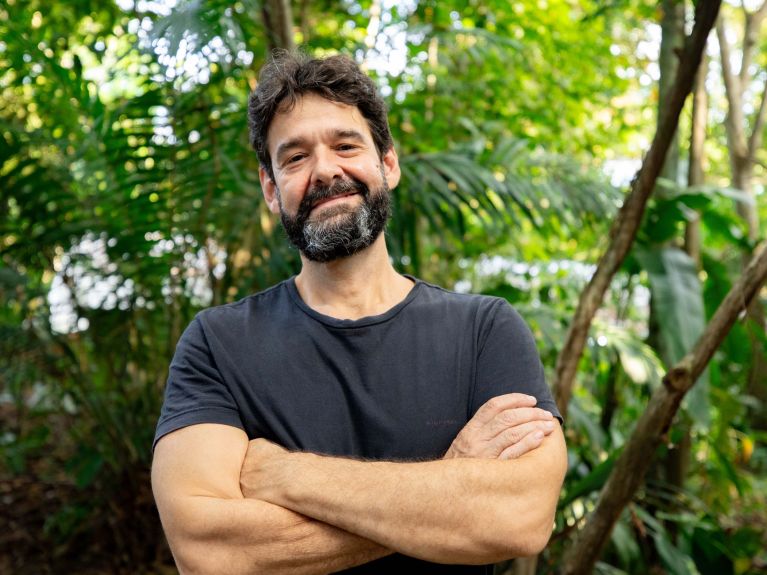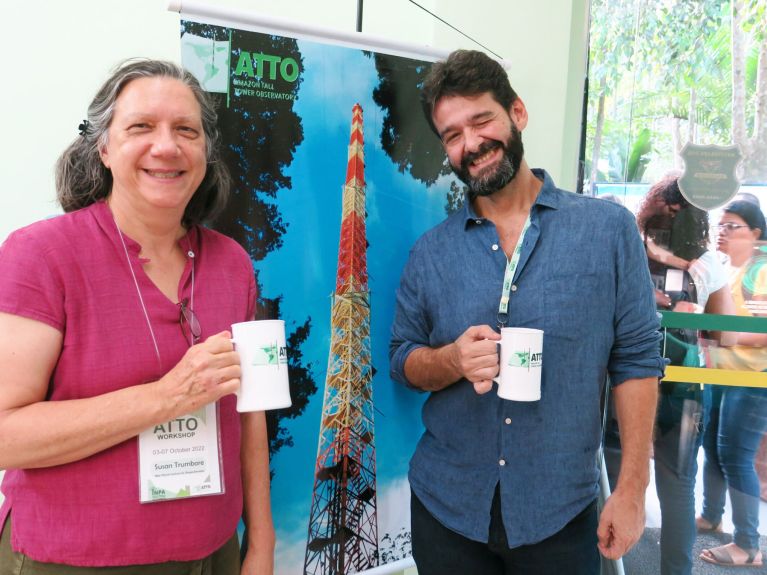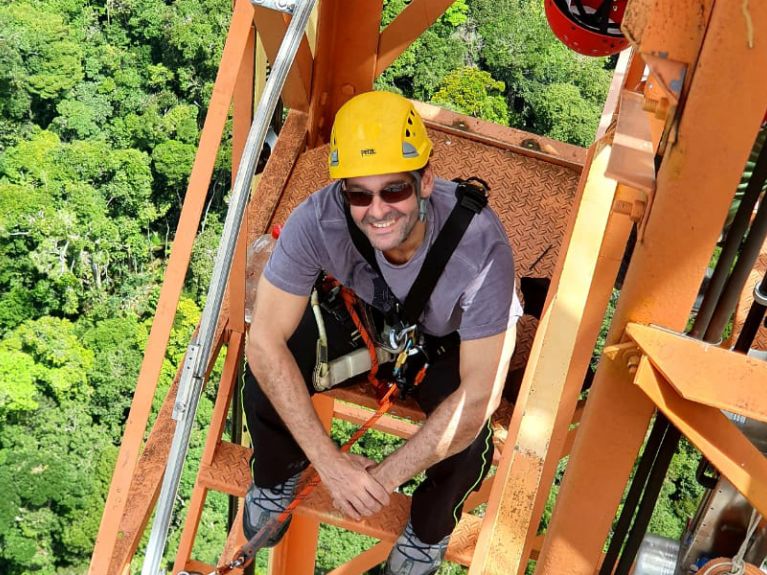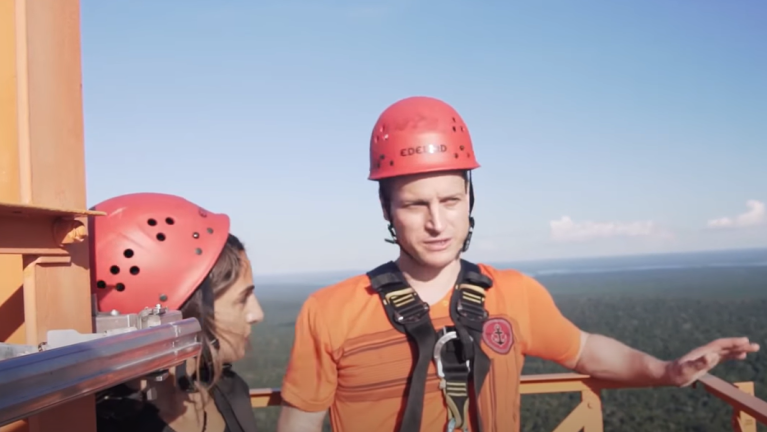The rain forest expert
Carlos Alberto Quesada runs the German-Brazilian research station ATTO in the Amazon together with Susan Trumbore from the Max Planck Institute.

Practising international networking: we present individuals who symbolise Germany’s partnerships around the world. Global challenges can only be overcome by working together.
When Carlos Alberto Quesada first stepped foot in the rain forest he couldn’t believe it. He was assaulted by all kinds of odours he had never expected there: it smelt of curry, of vanilla and of mud. And in some places, there was also the stench of excrement. Without realising it, the young scientist had ended up in an environment that now defines his life. The unexpected smells came from gases exuded by plants. When they rise up into the atmosphere, some of them can absorb moisture. They form clouds and release rainfall. Which is how the forest creates its own rainfall.
Dieses YouTube-Video kann in einem neuen Tab abgespielt werden
YouTube öffnenThird party content
We use YouTube to embed content that may collect data about your activity. Please review the details and accept the service to see this content.
Open consent formThough originally from the dry city of Brasília in the heart of the Cerrado savanna, Carlos Alberto Quesada, whom everyone calls just Beto, was fascinated by the Amazon even as a child. For more than six years, the forestry engineer has been responsible on the Brazilian side for the research station ATTO, a globally unique project roughly 150 kilometres from Manaus. A team of scientists there is researching the interactions between climate change and the rain forest.

ATTO is run by INPA, Brazil’s National Institute of Amazonian Research. Other key research partners include the Max Planck Institutes (MPI) for Chemistry and Biogeochemistry, the Karlsruhe Institute of Technology (KIT) and the Amazonas State University. On the German side, the project is led by Professor Susan Trumbore from the MPI.
The world’s tallest research tower
Germany and Brazil have equal responsibility for the project. Together, they built the world’s tallest research tower - it is 352 metres high. It allows the atmosphere above the virgin forest to be researched over a radius of a good 600 kilometres. At the same time, researchers at another station on the forest floor study particles, gases and their movements. Including those whose smells had made such an impression on Quesada when he was a student.
The rain forest is a hostile place - but hugely fascinating.
“The rain forest is a hostile place that can kill people,” says the man from the savanna, “but at the same time it is hugely fascinating.” Quesada lives in Manaus and undertakes the six-hour trip to the research station once a month. That gives him the chance to coordinate activities with the camp’s operational leader, to check that everything is in order and to discuss plans with the team.
The trip is arduous: Quesada travels by car along a dirt road, then boards a fast boat that takes him a bit further along the Atuma river. A jeep then transports him deep into the forest. Researchers, PhD students and staff at the camp sleep in hammocks in communal accommodation, eat river fish in the canteen and can have a hot shower in the evening, which is pretty luxurious for a rain forest camp. “The German engineer who originally located the right site for the camp had to battle his way through the forest with a machete,” explains Quesada.
Climate research as civil obligation
He regards climate research as a kind of civil obligation. “We do not know how much time we have left or how resilient the forests really are.” He believes that bilateral cooperation makes particular sense in this context, explaining that Germans are experts in aerosols, greenhouse gases and biochemistry, and concentrate on atmospheric questions. “Whereas we have centuries of experience of the ecological processes in the rain forest and know about the decomposition of matter and the gases that are produced as a result. And we are leaders in micrometeorology,” adds the Brazilian head of ATTO. The knowledge on the one side makes greater progress possible on the other.
New insights can influence weather forecasts all over the world.
The mood among the scientists is highly concentrated and tense. They are all aware that any one of them could make a major breakthrough at any time. “We still know very little about meteorological processes, and especially about the formation of clouds in the tropics. The theories from temperate zones cannot be applied here. New insights into the transport of matter and into temperatures can influence weather forecasts all over the world; the impacts on aviation could well be huge.”
Great hopes pinned on young researchers
The possibility of a groundbreaking discovery at any time is just one of the aspects that makes Quesada’s work so fascinating Another is the chance to train up young researchers: “I was trained in a single discipline but young researchers here have contact with leading scientists from different disciplines and countries from the outset. We will only be able to judge what that means in ten to 15 years, when this generation gradually replaces us.” Scientific research, having been slowed by the pandemic, is only really gathering pace now, he adds: “It will be very interesting to see what that will bring.“

To cope with all the challenges and responsibility, the 51-year-old tries to lead a balanced life, going to the gym every day and spending time with his girlfriend. Quesada says that he is not in fact a very systematic person: “But within my personal tendency to chaos I’m pretty well organised.” Recently, the scientist - a tall man - additionally took over the coordination of another project: “Amazon Face” is also in the rain forest - literally on the way to the ATTO tower. In cooperation with the United Kingdom, a project to simulate rising CO2 levels in the atmosphere is being developed there. “Currently, we are at roughly the same point at which my German colleague was with ATTO when he was battling his way through the jungle with a machete,” says Quesada with a smile, explaining his dual role as follows: “Perhaps I’m just a little bit of a megalomaniac.”



